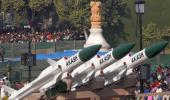The IAF can fire Brahmos missiles from several hundred kilometres away.
The BrahMos flies supersonic, at speeds up to Mach 2.5, giving the enemy little time to react, reports Ajai Shukla.

The supersonic BrahMos, already one of the world's most highly-regarded cruise missiles, has moved onto a fast-development track.
Six months after an advanced, Block III, land-attack BrahMos was successfully tested in the Andaman and Nicobar Islands, the defence ministry announced on Wednesday, November 22, the successful test of the first BrahMos air-launched cruise missile, launched from a Indian Air Force Sukhoi-30MKI fighter to strike a target floating in the Bay of Bengal.
The BrahMos air-launched cruise missile enhances the IAF's ability to strike heavily defended targets deep in enemy territory.
Instead of having to run the gauntlet of enemy air defence systems all the way to the target, the Sukhoi-30MKI can release an air-launched cruise missile from several hundred kilometres away, perhaps even without crossing the border.
The BrahMos' navigation system would be pre-fed the target's coordinates, enabling a pin-point strike.
While most contemporary cruise missiles, like the United States' Tomahawk or Pakistan's Babur, fly at subsonic speeds, making them vulnerable to being shot down, the BrahMos flies supersonic, at speeds up to Mach 2.5, giving the enemy little time to react.
Suitable targets for the BrahMos air-launched cruise missiles are terrorist camps deep inside enemy territory, high-value military targets like headquarters or tactical nuclear weapon batteries, enemy airfields or high-value strategic infrastructure.
'The completion of (the) tactical cruise missile triad will significantly bolster the IAF's capabilities in long-range air combat operations,' Defence Minister Nirmala Sitharaman tweeted after the test.
The ministry announcement noted this would 'significantly bolster the IAF's air combat operations capability from stand-off ranges'.
Land attack versions of the BrahMos are already in army service while naval warships like the Kolkata-class destroyers are armed with ship-launched BrahMos missiles for attacking targets ashore from the sea.
However, the size and weight of the BrahMos made an air-launched version a daunting developmental challenge.
To achieve this, two development agencies worked together. Hindustan Aeronautics Ltd modified two Sukhoi-30MKI fighters -- brutishly powerful aircraft already -- to carry a missile as large and heavy as the BrahMos.
Meanwhile, BrahMos Aerospace, the Indo-Russian joint venture that developed the BrahMos, shortened and lightened the original version, bringing it down to an 8-m missile that weighs 2,560 km.
HAL said this involved strengthening the Sukhoi-30MKI's airframe and installing new, heavy-duty mounting stations under the fighter's belly to carry the missile.
This was tricky, since even the shortened BrahMos extends ahead of the Sukhoi-30MKI's air intakes, potentially blocking the airflow to the engines.
Computer simulations by HAL and the Indian Institute of Technology-Mumbai, ensured the airflow remained unimpeded.
Another challenge was to ensure the BrahMos separates cleanly from the aircraft when fired, with the signal going from the cockpit, through the Sukhoi-30's 1553 data bus, to all 12 mounting stations.
Only after clearing the aircraft to a safe distance can the BrahMos missile's propulsion system ignite.
The BrahMos joint venture was established through an inter-government agreement between Moscow and New Delhi in February 1998.
The name BrahMos is an amalgam of two rivers -- the Brahmaputra and Moskva.
According to figures tabled in Parliament, India and Russia contributed the JV's share capital of $250 million in the ratio of 50.5 and 49.5 per cent respectively. This was enhanced by $50 million to develop the BrahMos air-launched cruise missiles.
'Therefore, the contribution from the Indian side was Rs 634 crores. DRDO also contributed Rs 370 crores to realise the required infrastructure, technologies, production facilities and systems for the Indian armed forces,' the government told Parliament in 2007.











